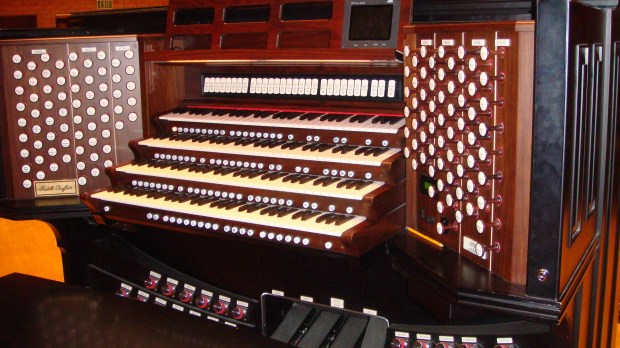From Jonathan Aigner over at Patheos, some good reasons why the best instrument for a lot of congregational singing is the increasingly-scarce pipe organ:
In my experience, the fiercest pipe organ opponents are baby boomers, who view the instrument as a symbol of the church of their youth, from which many persist in their rebellion, even in their advancing years. I believe it’s time to take another look at the unique benefits the organ can bring into worship. It sustains and strengthens congregational singing. Think of any other instrument commonly used in worship. Guitars, piano, percussion, or anything else. Once you play a sound on any of these instruments, what happens? It immediately begins to decay, necessitating more fills on the piano and more chords on the guitar. But singing doesn’t work this way, and the continuity of the sung line is often disrupted, sometimes violently so, by the constant reiteration of pitch required by the limitations of other instruments. But the organ’s sound lifts and sustains the voice of the congregation through each phrase, guiding each breath, and setting the character of the song through its wide range of voices. It fills a room naturally. Speaking of limitations, without amplification, it’s impossible for any other instrument to fill any but the smallest of spaces. The organ thrives in an open room, and consequently allows for a more organic accompanying sound. There is a reason organ accompaniment in church endured for centuries. It wasn’t because it was current. It wasn’t because it was cool. It wasn’t that it helped people feel “connected.” It was because the organ is uniquely able to support sustained, hearty congregational singing. As it fills the room almost like sunlight through open windows, the organ warmly invites even hesitant and untrained singers to join in. I have nothing against the piano or guitar. But those instruments were simply never meant to accompany congregational singing, and they are not well-suited to the task. An amplified band gives you a directional, electronic copy of the instruments. The pipe organ needs no electronic amplification; the natural sound of the instrument itself fills the space evenly and fully. Its range is massive. The organ can play from the quietest piano to the broadest forte, and can do so with a countless number of sound combinations. It’s palate of textures and colors is seemingly unending, and when played artistically and sensitively, it can breathe musical life into any part of the Gospel story. It facilitates a wide range of musical styles. As I talked about in another recent post, there are many styles of music that reside under the umbrella of traditional worship, and the organ can quite competently accompany almost any of these. Even Bart Simpson understands this.
You’ll want to read it all. Meantime, check out the performance below. Not long ago, a pipe organ was dedicated at Our Lady of Refuge in Brooklyn. For the rededication service, led by the bishop, the entrance hymn, “Holy God, We Praise Thy Name,” was sung by the congregation a capella. The closing hymn was the same piece of music, but with the organ.

